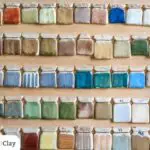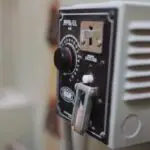The beginner or hobbyist can start molding clay at a cost between $200-$1,200. Your total costs will depend on a number of factors, such as whether you need a kiln or a potter’s wheel. Pottery equipment generally comes in a wide range, and the beginner can get by with some basic equipment. So, if you are just starting out, there is no need to worry about purchasing a $2,000 kiln!
Your journey into this artform can start with some handholding and classes at a local studio that already has wheels and a kiln. You do not need a full pottery studio to get started. Experienced potters may have additional considerations, such as the cost of a digital kiln.
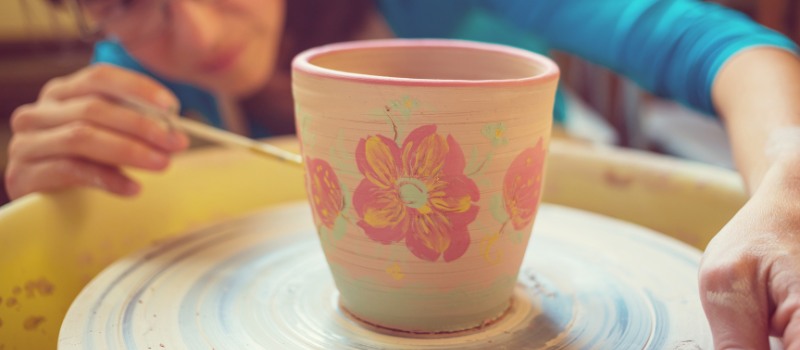
Determining Your Costs: A Starting Point
- The type of pottery you want to make: If you plan on making functional pottery, you will need to purchase different types of clay and glazes than if you plan on making decorative pottery.
- The size of your projects: Larger projects will require more clay and glaze, so you will need to budget accordingly.
- The frequency of your pottery sessions: If you plan on working with pottery on a regular basis, you will need to purchase more supplies than if you only plan on working with it occasionally.
Please note the prices here are general and subject to change! Use them as a guide. Click the tabs below to expand.
Clay
- Earthenware clay is low firing and suitable for decorative pieces, costing between $10-$15 for 10 pounds.
- Stoneware clay has a higher firing temperature and is suitable for functional pottery, costing between $25-$35 for 50 pounds. (Air dry clay may cost more).
- Porcelain clay is delicate and expensive, often used for fine ceramics, with a starting price of $28-30 for 10 pounds.
The actual price of a particular type of clay type can vary depending on the brand, size, and quality of the clay, but these are good starting points.
Glaze
- Range from $10-$25 for 16 ounces of decent quality underglaze.
- Overglazes can range from $15 for clear to $75+ for specialty luster overglazes.
Basic Supplies & Tools
- Kiln furniture can range from $10 to $100+.
- Cones are cheap and used in the firing process.
- Basic throwing tools cost around $10 to $20 each.
- Brushes for glazes range from $5 to $15 each.
- Drying racks cost around $20 to $50.
- Scrapers cost $5 to $10, ribs range from $8 to $15.
- Wire clay cutters cost $6 to $12, sponges around $5 to $8.
- Needle tools are priced at $3 to $6.
Studio Time & Lessons
- Studio lesson costs vary based on location, equipment, and guidance provided. We’ve seen many entry level classes start at $30 per class.
- A master class or lessons focused on specific techniques will usually cost more.
- Generally, a you will be able to find a local pottery class that is priced for your budget. Call to learn more, since not-so-obvious studios fees, such as for firing your pieces, could add up!
Kilns
- Small tabletop kilns: Like their name suggests, they are typically small and portable. A good option for beginners. Prices range from $200-$500.
- Medium-sized kilns: These kilns are larger than tabletop kilns to accommodate more pottery. Prices range from $500-$1,500.
- Large kilns: Typically used by professional potters. Prices range from $1,500-$5,000.
Your kiln size determines the quantity of pottery that can be fired at once. There are other things to consider, such as gas fired or electric, unique kiln shapes, electrical wiring and more! if you are a beginner, attend a class first before committing to a kiln purchase.
Potter’s Wheels
- Kick wheels: require physically moving a flywheel to operate. Generally cost between $100-$1,000 for higher end units.
- Tabletop pottery wheel: usually electric and small enough to fit on a table top, with or without short legs. These can be had for the reasonable price of $120.
- Electric Wheels: Operated electronically with a foot pedal. These cost between $100-$2,000+.
Kick wheels are a more simple option, but may not offer as much precision and control. Choose a wheel that best fits your needs.
As you see, the total cost to get started with pottery can vary depending on many factors. Below we’ll cover some of the most common tools in-depth.
Pottery Wheels
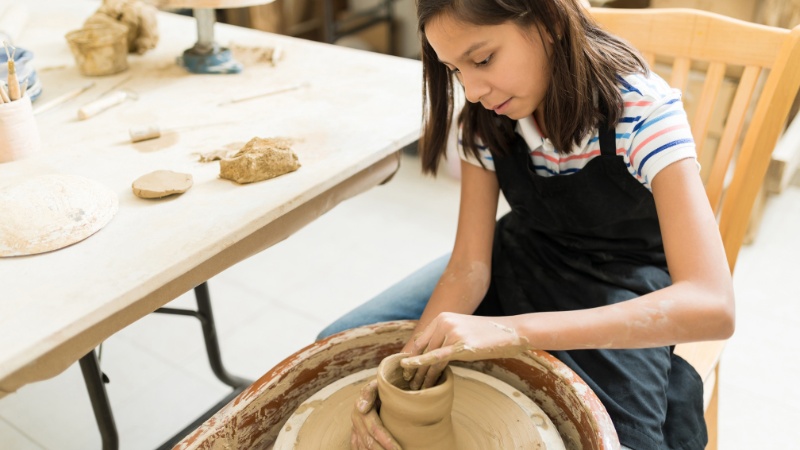
- Kick wheels: require physically moving a flywheel to operate. Generally cost between $100-$1,000 for higher end units.
- Tabletop pottery wheel: usually small enough to fit on a table top, with or without short legs. These can be had for the reasonable price of $120.
- Electric Wheels: Operated electronically with a foot pedal. These cost between $100-$2,000+.
Kick wheels are a simpler option, but they may not offer as much precision and control. You should choose a wheel that best fits your needs. Choose a wheel that best fits your needs. Pottery wheels are used to spin and shape clay into desired shapes. Prices range from $250-$3,000. A good entry-level wheel option would be a kick wheel for around $350-$500.
When it comes to pottery wheels, it’s all about finding the perfect match. Picture this: manual kick wheels, where potters use their feet to spin the wheel like a dance of craftsmanship. It’s an age-old technique that delivers hands-on creativity with a touch of tradition. (Talk about putting your best foot forward!)
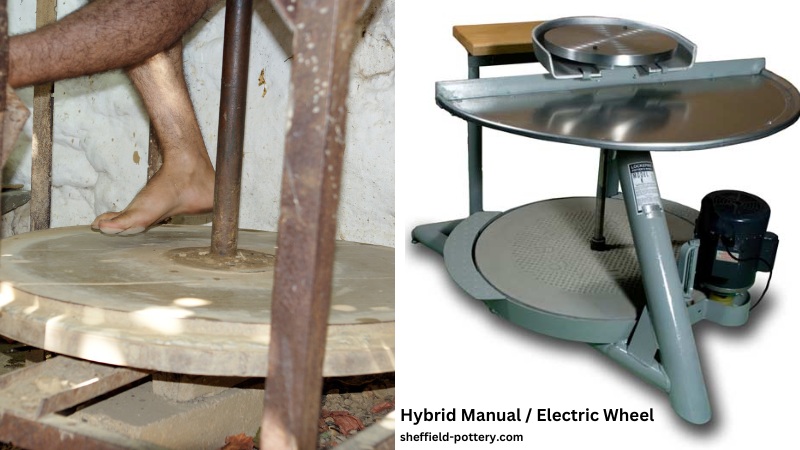
On the flip side, we have electric wheels, the sleek and precise powerhouses of pottery. With their electrifying spin, they offer control and finesse that would make even the smoothest salsa dancer envious. This is what we use, and are best for beginners.
Kilns
When it comes to pottery, there are three main types of kilns: electric, gas, and wood-fired. Each type has its own unique advantages and disadvantages, so it’s important to choose the right one for your needs.
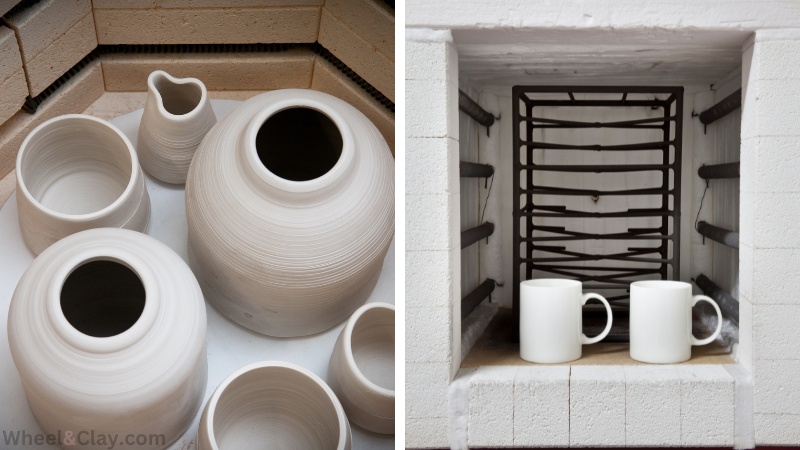
Electric kilns are the most popular type of kiln for beginners. They’re easy to use and maintain, and they can reach high temperatures quickly. However, they can be more expensive than other types of kilns.
Gas kilns are a good option for potters who want more control over the firing process. They can reach even higher temperatures than electric kilns, and they can create more dramatic effects. However, gas kilns can be more dangerous than electric kilns, and they require more maintenance.
Wood-fired kilns are the most traditional type of kiln, and they’re often used by potters who want to create pieces with a unique character. Wood-fired kilns can create beautiful, textured effects, but they’re also the most difficult type of kiln to use. They require a lot of time and attention, and they can be dangerous if not used properly.
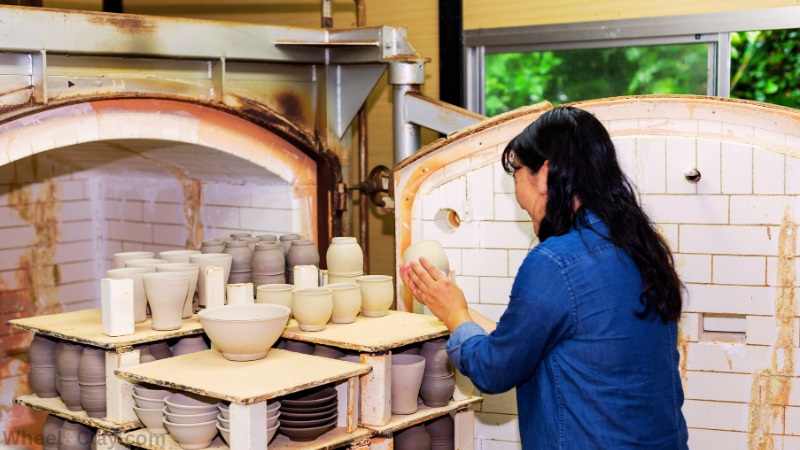
So, which type of kiln is right for you? It depends on your individual needs and preferences. If you’re a beginner, you might find an electric kiln to be a good option. If you’re looking for a traditional kiln that can create unique effects, you might want to consider a wood-fired kiln.
No matter which type of kiln you choose, remember that the right equipment is the key to unlocking your creative dreams. So get out there and start making some pottery!
Sales: Pricing Your Pottery
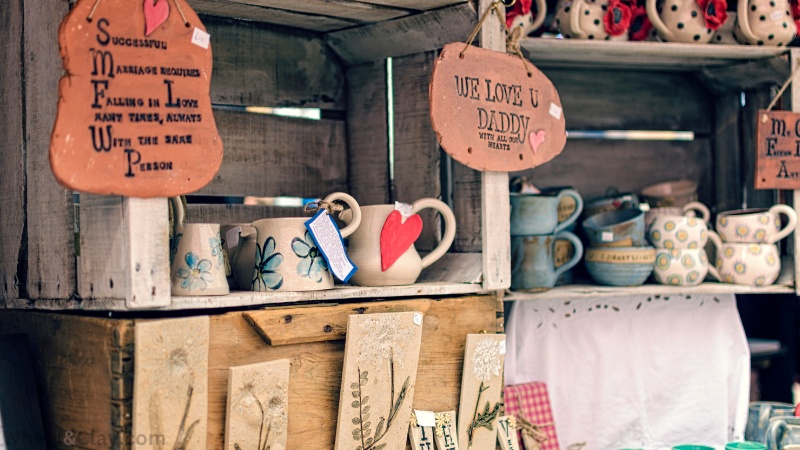
We don’t recommend starting pottery as a business endeavor, at least not at the beginning. However, many of my friends do sell their pottery pieces locally, at fairs and farmer’ markets. How you price your pottery is personal. Make sure to factor in the cost of materials, your time, and how your want your brand tp be perceived. For cups and mugs, $15-$20 is a safe zone. As you establish your art and hone your skill, you can charge even more (supply and demand still applies).
Studio Space
Before you run out and purchase equipment, plan on where you will use it. I doubt the kitchen will be a good place! I have a friend who had a similar experience: she invested in a large electric kiln. Everything seemed fine when it arrived and she signed off on it. However, she later realized that her space was not wired for a 240-volt circuit and a 50-amp breaker! An electrician fixed the issue, but it cost over $350.
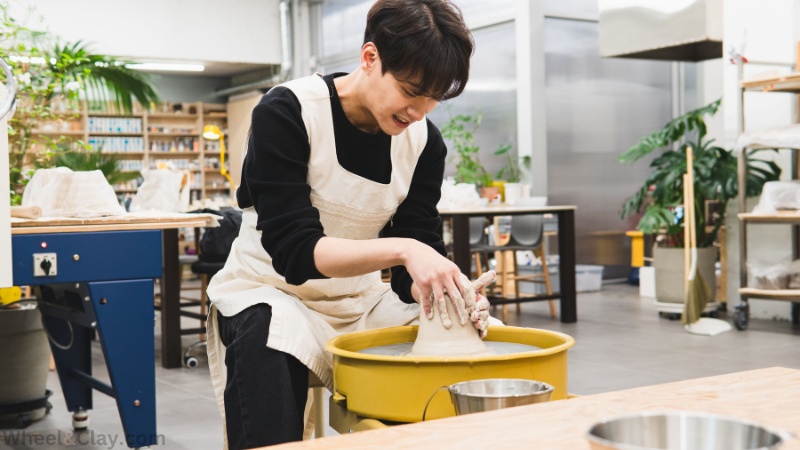
Here are my personal recommendations for anyone looking to set up a home studio space.
- If you can get natural lighting, do it! Windows are great.
- A sink with a clay trap. Easier than rinse buckets and cheaper than tearing out your plumbing do to clay buildup!
- Enough space for the equipment you need.
- Good ventilation, a combination of fans, a clean studio and windows can help here.
Summary
Getting started in pottery and ceramics does not need to be expensive! You can start with classes to dip your toes in the water, and continue from there. A hobbyist can spend a minimal amount on a clay wheel, and a smaller kiln for firing. (That’s if you need it at all!).
Common types of clay and materials have price points that are very accessible as well. Expensive equipment is usually found in the intermediate and professional range.
My recommendation? Give it a try!
Joanna Miller
Clay Maven
I’m an artist and educator who’s head over heels in love with pottery and ceramics. Seriously, I’ve got clay running through my veins! From the moment I first touched that squishy, magical substance as a kid, I knew I had found my calling. Now I help others, from hobbyists to professionals, become their best self.




